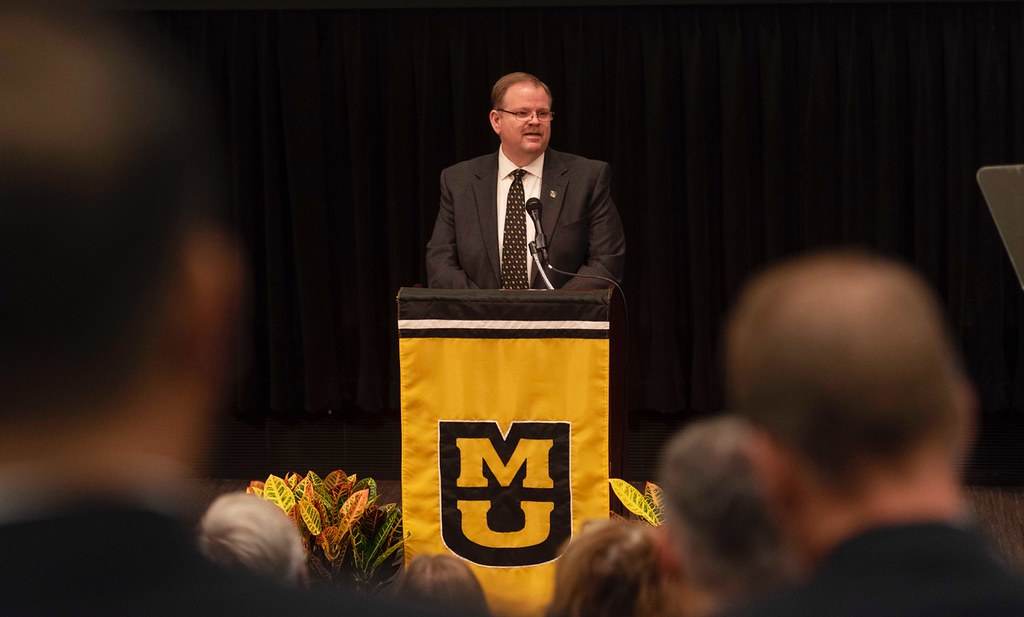Published on
Focus on new grants results in research funding bump

By Mariah Cox | Bond LSC
It’s an inconvenient truth that every scientist knows; progress in research is driven by the money they receive to pursue discoveries.
As MU’s Chancellor Alexander Cartwright addressed the Mizzou community in October, he announced positive gains in securing grants for future science.
“Not long ago, we set an ambitious goal to double research funding by 2023. I’m thrilled to report that last year, our research awards – an indicator of future expenditures – increased from around $200 million to $250 million,” Cartwright said at the 2019 State of the University Address. “This almost 25% increase in awards in one year is phenomenal.”
Bond Life Sciences Center’s 29 research faculty are slightly outpacing this system-wide achievement, with the FY2019 report displaying a year-over-year increase from $13.3 million in FY2018 to $16.8 million. That’s an increase of 26% in grant funding from agencies like the National Science Foundation, the National Institutes of Health, the U.S. Department of Energy and other sources.
“As a faculty member, I would say we’re always motivated to get grants, but sometimes it is a little bit cyclical and depends on how good the federal budget is in various research areas,” Bond LSC Interim Director Walter Gassmann said. “But I do think the Chancellor’s challenge of doubling our research expenditures in five years was a big motivator for researchers because they realized people are paying attention.”
That challenge started in February 2018 when Cartwright announced the renewed focus. Within the first year, research faculty across campus answered that challenge head-on, increasing grant funding from $207 million to $255 million, a 23% rise.
It’s not just researchers getting more grants or submitting more proposals, but there seems to be renewed interest in larger grants. In Bond LSC, the amount requested has risen by almost 70%.
Cartwright’s challenge also sparked a change in the grant-seeking landscape. Now, researchers across campus are encouraged to collaborate with each other more and go after larger grants together, rather than compete with each other for smaller grants.
One way Bond LSC encourages collaboration and the startup of new studies is through seed grants. These help them get proposals off the ground with up to $100,000 to get their projects up and running.
“Funding has become so competitive you can’t just have a good idea. The more data you have, the better you can convince reviewers that the project will really work,” Gassmann said. “In a way, it’s counterintuitive. You write these grants and say, ‘I really need this money to prove that it’ll work,’ but the reviewers come back and say, ‘show me that’ll work and then we’ll give you the money.’ That’s always a balancing act.”
A significant intent of seed grants is to stimulate teamwork. Applications require both collaboration and for researchers to propose something they haven’t done before. Eight proposals were funded in the last round.
“The program has been very successful when you compare how much investment we put into seed grants and how much federal funding came out of previous rounds of Bond LSC seed funding. It was almost seven to one,” Gassmann said. “To me, that makes it seem like it was a good investment.”
The UM System recently built on this concept with a series of grants to enhance the ‘well-being for Missouri, the nation and the world through transformative teaching, research, innovation, engagement and inclusion,’ investing millions in strategic projects across Missouri.
Additionally, Bond LSC sets up “hot topics” lunches where scientists build bridges for potential collaborations. They help researchers meet other people on campus who they could team up with and apply for larger grants. These monthly meetings for metabolomics, microbiology and cancer researchers across campus help identify and form collaborations.
Julia Rodriguez, lead grant writer for Bond LSC, specializes in identifying new funding opportunities and potential collaborations as well as refining the grant applications. She regularly alerts researchers across campus to new funding opportunities.
“I think our investigators are very creative and they have the support from the administration to think bigger,” Rodriguez said. “When investigators are looking for potential grants, we help them attack the situation from another angle. We teach them how to search for grants and where to search. We talk with them about outside-the-box opportunities and help them frame their question a little differently to compete for funding from different sources, so that they have a broader portfolio.”
One example of this continued grant success is Primary Investigator Jay Thelen. He was awarded a $3.4 million National Science Foundation (NSF) Plant Genome Research Program Grant to study metabolic constraints and regulatory nodes in engineered oilseeds. The grant was the fourth grant awarded to Bond LSC researchers in recent years by the NSF Plant Genome Research Program, which focuses on large collaborative projects, and all four are currently active.
But, it takes a concerted effort from faculty and staff to ensure everything is in order for federal granting agencies.
“Having knowledgeable and dedicated staff like Julia Rodriguez and Patience Okiring in close contact with our faculty is key to our high rate of grant success,” Gassmann said. “Not only are they familiar with the wide variety of funding agencies, but they also get to know the faculty well and know what funding opportunities might be of interest to them.”
The main motivation for the increase in grant funding is to strengthen Mizzou’s reputation as a leading research institution and attract talented faculty, students and postdoctoral fellows. By increasing grant funding, Mizzou can indirectly increase student enrollment, attract talented faculty and improve an already vibrant research environment.
“There are only 24 hours in a day, and you have to spend it on what you feel is important. There has always been an expectation of external funding,” Gassmann said. “Bond LSC faculty are very driven and entrepreneurial from the get-go. Chancellor Cartwright’s expectation to double research funding within 5 years was a welcome challenge for us.”